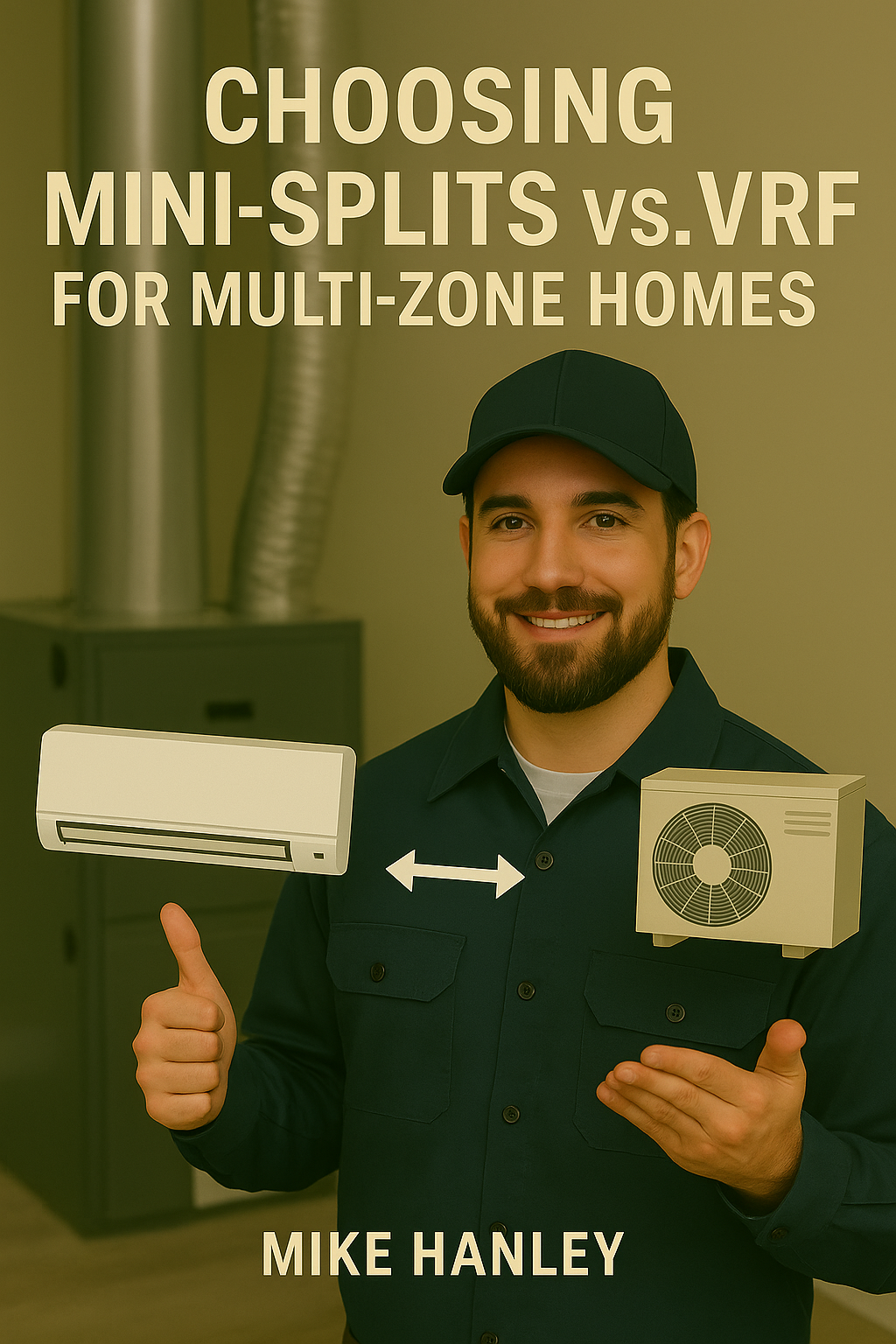📘 Table of Contents
🏠 Why the Choice Matters
When planning a multi‑zone HVAC system, the decision between a multi‑zone mini‑split or a VRF (Variable Refrigerant Flow) system isn’t minor, it impacts your budget, installation complexity, long-term maintenance, and how well each area of your home stays comfortable.
Both use refrigerant-based systems and support zoned heating and cooling, but they differ in control, scalability, and cost. Understanding how they work and when each fits is key to making the right investment.
🧩 Mini‑Split Systems Explained
Mini‑split systems are ductless, direct-expansion heat pumps. A single outdoor condenser connects to multiple indoor air handlers (or “heads”) via refrigerant lines. Each head operates independently and is controlled by its own remote or wall-mounted thermostat.
These systems are excellent for 1–5 zone applications. MRCOOL DIY multi-zone kits offer an ideal setup for homeowners wanting to save on installation by using pre-charged linesets.
Mini-splits are especially effective in homes without existing ductwork or in retrofit projects where duct installation would be costly or impractical. Check out our full mini-split systems collection for available configurations.
🔍 What Is a VRF System and How It Works
VRF systems are advanced HVAC solutions originally developed for commercial use. They utilize a central outdoor unit connected to a network of indoor units via a refrigerant branch system. These setups use variable-speed compressors and branch boxes (or Y-joints) to modulate refrigerant flow per zone.
Some VRF systems support simultaneous heating and cooling across different zones (known as heat recovery VRF), making them ideal for larger, more complex homes.
Unlike mini‑splits, VRF systems are not DIY-friendly. They require certified technicians for design, installation, and maintenance. According to ASHRAE, proper design is essential for capacity control, zoning accuracy, and refrigerant charge management.
📈 Mini‑Split vs. VRF: Side‑By‑Side Comparison
This side-by-side overview highlights the key differences to consider:
|
Feature |
Mini‑Split (Multi‑Zone) |
VRF (Variable Refrigerant Flow) |
|
Cost (Upfront) |
Lower – DIY or simple install |
Higher – Requires pro design/install |
|
Scalability |
1–5 zones |
6–20+ zones with modular control |
|
Controls |
Independent remotes |
Centralized smart/BAS integration |
|
Refrigerant Layout |
One line set per indoor unit |
Branch boxes or Y-joint distribution |
|
Efficiency |
High at part load (9–24k BTU heads) |
Excellent in large applications w/ VSD |
|
Serviceability |
Easy to access and maintain |
More complex with advanced diagnostics |
Energy.gov’s VRF page emphasizes VRF advantages in efficiency and zone control, especially for larger buildings, but they are rarely cost-effective for homes under 3,000 sq ft.
📚 Use Scenarios: When to Choose Which
Choose Mini‑Splits When:
-
You need 2 to 5 zones with limited ductwork
-
You want the option for DIY installation
-
Budget is a top priority
-
You’re remodeling or adding zoned control to an existing space
Mini‑splits are ideal for open-plan homes, sunrooms, garages, and secondary structures where ducting is difficult or not feasible.
Choose VRF When:
-
Your home has more than 5 zones
-
You need precise load balancing across different rooms and floors
-
You want centralized controls, remote sensors, or integration with a building automation system (BAS)
-
You plan for simultaneous heating and cooling in different zones
VRFs work best in high-end homes, multi-level residences, or luxury remodels where zoning complexity justifies the cost.
✅ Key Takeaways & What to Read Next
Mini-splits are best for homes needing up to 5 zones, especially when you want simpler controls and potential for DIY savings.
VRF systems are a better fit for complex layouts and high-end homes needing scalable, integrated zone control.
Continue the series with the next in-depth guides:
-
➡️ Part 3: Matching System Layout to Home Design
-
🔙 Back to Main Topic: Choosing the Right HVAC System for Multi‑Zone Homes
❓FAQ
Q: Are mini-splits and VRF systems the same?
A: Not quite. While both are refrigerant-based, mini-splits use individual line sets, while VRF uses centralized distribution and controls.
Q: Why are VRFs more expensive?
A: They require specialized design, custom refrigerant routing, and BAS-compatible control setups, making labor and material costs higher.
Q: Can mini-splits handle part-load zones well?
A: Yes. Most modern inverter-driven mini-splits perform efficiently across a range of loads.
Q: Can I use VRF with existing ductwork?
A: Not typically. VRF systems use refrigerant-fed indoor units and are not compatible with conventional duct systems.
Q: Which is easier to service?
A: Mini-splits, by far. Their simpler layout and fewer joints reduce diagnostics and repair time.







